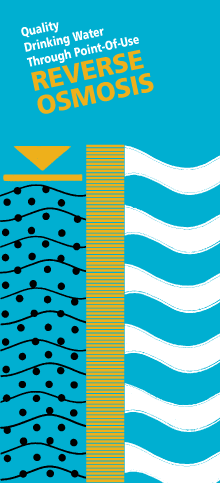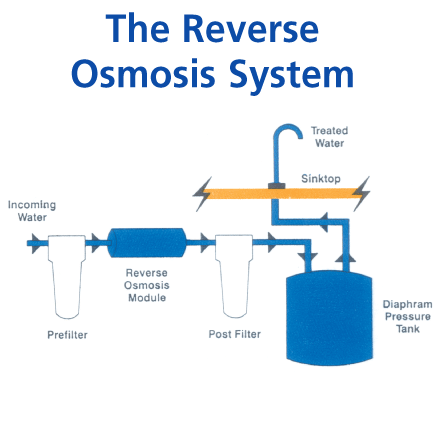Point-of-Use Reverse Osmosis Water
The Natural Refresher
Clean, clear, life-giving water! Next to air, it’s the substance most necessary for our survival. 70% of our total body weight is made up of water which constantly circulates, cleanses, and renews the body. Consider the importance of water in maintaining a healthy body…
- It increases endurance and energy levels
- It aids digestion and elimination
- It regulates body temperature
- It facilitates muscular and nervous activity
- And, it provides the perfect medium to carry nutrients, oxygen, and disease fighting antibodies.
It’s no wonder every prescription for health includes drinking six to eight glasses of quality water per day! Considering the importance of water, doesn’t it make good sense to have a source of quality water in your home?
How Reverse Osmosis Works
A point-of-use reverse osmosis (RO) water quality improvement system can provide clear, fresh water in your home. These compact units are designed to force pressurized water through a semi-permeable membrane which rejects contaminants suspended in the water. This membrane permits passage of the improved water to a holding tank. It is then available for use for drinking, cooking, or making ice cubes.
Questions and Answers about Point-of-Use Reverse Osmosis Systems
Q: How effective is the reverse osmosis method for improving water quality?
A: RO is very effective, with high levels of contaminant reduction for point-of-use water quality improvement. This is possible because the reverse osmosis membrane is comprised of microscopic pores which allow the pressurized water molecules, which are among the smallest molecules known to man, to pass through the membrane. Consequently, large molecules and compounds containing contaminants like those listed in this brochure can be left behind. There is also a very complex process involving dielectric interactions and other molecular forces that takes place at the surface of the RO membrane. This second mechanism is effective in rejecting or repelling charged mineral ions from passing through to the RO water product.
Q: Why is water so easy to pollute?
A: Although water is one of the simplest substances known to man, containing two hydrogen molecules and one oxygen molecule, it is also one of the easiest to contaminate. Known as the “universal solvent, water dissolves or takes into suspension a little bit of everything it comes in contact with, from beneficial elements to harmful chemicals and minerals.
Q: What about microbiological contaminants in the water?
A: The RO membrane is, in effect, a microscopic screen which blocks out many contaminants from the water, including some specific microbiological contaminants. The pore size of the RO membrane determines the rate of reduction.
Q: How does reverse osmosis differ from osmosis in nature?
A: With normal osmosis, fluids pass through a semipermeable membrane (like a filter) from an area of high concentration until the fluid concentration on both sides of the membrane becomes equal. The movement of the water from soil to plant roots is an example of osmosis in nature. With reverse osmosis, just the opposite happens. By applying artificial pressure to the water solution of higher solids concentration (the incoming water), the flow of liquid is reversed. Under these conditions, the membrane allows only water with reduced contaminants to pass through leaving a high percentage of the contaminants behind.
Q: What are the other benefits of installing a reverse osmosis water quality improvement system?
A: There are many benefits besides greatly reduced concentrations of contaminants. Cleaner, sparkling drinking water is probably the most noticeable. because there is little to alter the water’s natural state, the flavor of food can come through unadulterated by any “chemical” taste. Brewed items like coffee, tea, or soups may have a richer, more robust flavor. Fruit juices and powdered drinks may taste better when they are mixed with water from an RO system. Even ice cubes can take on a crystal clear appearance.
Q: Will reverse osmosis remove all contaminants from my water?
A: The level of contaminant reduction for reverse osmosis will vary. Reductions depend on conditions such as the degree of contamination, the size and type of equipment, system pressure, and product maintenance. No system can be warranted for total elimination of all contaminants in all conditions. Consult your local WQA professional or the manufacturer for additional information.
Q: How do I select the right point-of-use reverse osmosis system, and what are my alternatives?
A: The capabilities and specifications of equipment varies from manufacturer. It is best to consult with your local professional who can help you select the correct model for you. Keep in mind that an easily installed, under the- sink RO system can provide refreshing water for just pennies a gallon.
Information

Reduces:
- Unpleasant Tastes
- Unpleasant Odors
- Scale Producing Minerals
- Lead
- Copper
- Sodium
- “Cloudy/Foggy” Appearance
- Nitrates
- Certain Pesticides and Fungicides
- Certain Volatile Organisms Contaminants
- Radium
Consumer Tips
If you are considering the purchase or rental of point-of-use (POU) water quality improvement equipment, here are a few consumer tips from the Water Quality Association (WQA):
- If you suspect you have a problem with your water, have it tested to confirm the nature and extent of the problem. For aesthetic problems like hardness, your water can be analyzed in your home by a professional such as a WQA Certified Water Specialist (CWS); for health concerns, consult a state certified or other reputable laboratory, then work with a professional to select equipment.
- Be an educated consumer. Research the water quality improvement products available before you buy. Check performance capabilities, warranty, maintenance provisions, what contaminants the product reduces and to what level, and general operation.
- Price is an important factor, but don’t let it be your only criteria. Capacity, special features or company services are factors you may wish to consider in making a wise choice.
- All products require maintenance or periodic replacement. Determine who will perform these functions.
- Look for the WQA Gold Seal on the POU equipment. It indicates a production model of the equipment was tested and found to meet industry performance standards.
- Research the reputation and legitimacy of the company or sales representative you choose. You may want to check customer references before you sign a contract.
- Be aware that multiple water quality problems may require multiple product solutions, a “systems” approach which combines several technologies in one system.


